Torsobarography: Intra-Observer Reliability Study of a Novel Posture Analysis Based on Pressure Distribution
Abstract
1. Introduction
2. Materials and Methods
2.1. Participants
2.2. Instrumentation
2.3. Measurement Procedure
2.4. Data Preprocessing
2.5. Landmark Identification
2.6. Parameter Extraction
2.6.1. Approximation of the Frontal and Sagittal Spine Shape
- : Summation of the absolute differences between adjacent points of
- : Variance of
- : Mean value of in thoracic region in relation to mean value of in lumbar region
- : Lateral deviation of in the upper thoracic and lower lumbar region
- : Maximum deviation of to the symmetry axis
- : Summation of the deviations of the points of to the points of
- : Absolute value of the first coefficient of describing the slope of ( defines the vertical intersection of the following linear equation)
- : Angle describing the shape of the thoracic curve (associated with the kyphosis angle) is determined by the slope of mean pressure intensities between as and as
- : Angle describing the shape of the lumbar curve (associated with the lordosis angle) is determined by the slope of mean pressure intensities between as and as
- : Ratio of thoracic maximum to lumbar minimum
- : Ratio of summed thoracic pressure intensities to summed lumbar pressure intensities
- : Ratio of mean thoracic pressure intensities to mean lumbar pressure intensities
- : Slope between thoracic maximum and lumbar minimum
- : Ratio of thoracic maximum to reference value
- : Ratio of lumbar minimum to reference value
2.6.2. Morphological Structures of the Thoracic Region
- : Vertical shift between left and right shoulder edges
- : Maximum ratio of the slope coefficients of
- : Vertical shift of the localised scapula centres
- : Horizontal shift of the localised scapula centres to the axis of symmetry
- : Angle between the localised scapula centres
- : Maximum ratio of scapula maxima between and
- : Maximum ratio of mean pressure intensities between and
- : Summed deviation between centre of pressure curve and symmetry axis
- : Maximum ratio between the mean values of and
- : Maximum ratio between maximum pressure intensities of and
- : Maximum ratio between the summed pressure intensities of and
- : Summation of the percentage differences between and normalised to power of the set within the overlapping section
2.6.3. Morphological Structures of the Lumbar Region
- : Vertical shift of the waist centres
- : Difference horizontal shift of the waist centres to the symmetry axis
- : Angle between both waist centres
- : Maximum ratio of the quadratic coefficients of the second-degree polynomial regression of the left and right waist contour
2.6.4. Morphological Structures of the Sacral Region
- : Slope of in the interval
- : Summed vertical shift of the upper and lower edges of the segmented sacral imprint
- : Maximum ratio between the summed pressure intensities of the left and right sacral region
- : Maximum ratio between the mean pressure intensities of the left and right sacral region
2.7. Statistical Analysis
3. Results
3.1. Landmarks and Reference Distances
3.2. Approximated Frontal and Sagittal Spine Curve
3.3. Thoracic Region
3.4. Lumbar Region
3.5. Sacral Region
4. Discussion
4.1. Intra-Observer Reliability of Different Parameter Groups
4.2. Limitations and Future Works
5. Conclusions
Author Contributions
Funding
Institutional Review Board Statement
Informed Consent Statement
Data Availability Statement
Conflicts of Interest
References
- Ghaneei, M.; Komeili, A.; Li, Y.; Parent, E.C.; Adeeb, S. 3D Markerless asymmetry analysis in the management of adolescent idiopathic scoliosis. BMC Musculoskelet. Disord. 2018, 19, 385. [Google Scholar] [CrossRef]
- Stokes, I.A.F.; Armstrong, J.G.; Moreland, M.S. Spinal deformity and back surface asymmetry in idiopathic scoliosis. J. Orthop. Res. 1988, 6, 129–137. [Google Scholar] [CrossRef]
- Le Huec, J.C.; Thompson, W.; Mohsinaly, Y.; Barrey, C.; Faundez, A. Sagittal balance of the spine. Eur. Spine J. 2019, 28, 1889–1905. [Google Scholar] [CrossRef]
- Patias, P.; Grivas, T.B.; Kaspiris, A.; Aggouris, C.; Drakoutos, E. A review of the trunk surface metrics used as Scoliosis and other deformities evaluation indices. Scoliosis 2010, 5, 12. [Google Scholar] [CrossRef]
- Charles, Y.P.; Daures, J.-P.; De Rosa, V.; Diméglio, A. Progression risk of idiopathic juvenile scoliosis during pubertal growth. Spine 2006, 31, 1933–1942. [Google Scholar] [CrossRef]
- Bettany-Saltikov, J.; Weiss, H.-R.; Chockalingam, N.; Taranu, R.; Srinivas, S.; Hogg, J.; Whittaker, V.; Kalyan, R.V.; Arnell, T. Surgical versus non-surgical interventions in people with adolescent idiopathic scoliosis. Cochrane Database Syst. Rev. 2015, 4, CD010663. [Google Scholar] [CrossRef]
- Negrini, S.; Donzelli, S.; Aulisa, A.G.; Czaprowski, D.; Schreiber, S.; De Mauroy, J.C.; Diers, H.; Grivas, T.B.; Knott, P.; Kotwicki, T.; et al. 2016 SOSORT guidelines: Orthopaedic and rehabilitation treatment of idiopathic scoliosis during growth. Scoliosis Spinal Disord. 2018, 13, 3. [Google Scholar] [CrossRef] [PubMed]
- Penha, P.J.; Penha, N.L.J.; De Carvalho, B.K.G.; Andrade, R.M.; Schmitt, A.C.B.; João, S.M.A. Posture alignment of adolescent idiopathic scoliosis: Photogrammetry in scoliosis school screening. J. Manip. Physiol. Ther. 2017, 40, 441–451. [Google Scholar] [CrossRef] [PubMed]
- Chowanska, J.; Kotwicki, T.; Rosadzinski, K.; Sliwinski, Z. School screening for scoliosis: Can surface topography replace examination with scoliometer? Scoliosis 2012, 7, 9. [Google Scholar] [CrossRef] [PubMed]
- Fortin, C.; Feldman, D.E.; Cheriet, F.; Labelle, H. Clinical methods for quantifying body segment posture: A literature review. Disabil. Rehabil. 2011, 33, 367–383. [Google Scholar] [CrossRef] [PubMed]
- Knott, P.; Pappo, E.; Cameron, M.; Demauroy, J.; Rivard, C.; Kotwicki, T.; Zaina, F.; Wynne, J.; Stikeleather, L.; Bettany-Saltikov, J.; et al. SOSORT 2012 consensus paper: Reducing x-ray exposure in pediatric patients with scoliosis. Scoliosis 2014, 9, 4. [Google Scholar] [CrossRef]
- Pan, Y.; Chen, Q.; Chen, T.; Wang, H.; Zhu, X.; Fang, Z.; Lu, Y. Evaluation of a computer-aided method for measuring the Cobb angle on chest X-rays. Eur. Spine J. 2019, 28, 3035–3043. [Google Scholar] [CrossRef] [PubMed]
- Imran, A.-A.-Z.; Huang, C.; Tang, H.; Fan, W.; Cheung, K.; To, M.; Qian, Z.; Terzopoulos, D. Fully-automated analysis of scoliosis from spinal X-ray images. In Proceedings of the IEEE 33rd International Symposium on Computer-Based Medical Systems (CBMS), Rochester, MN, USA, 28–30 July 2020; pp. 114–119. [Google Scholar]
- Lee, H.M.; Kim, Y.J.; Cho, J.B.; Jeon, J.Y.; Kim, K.G. Computer-aided diagnosis for determining sagittal spinal curvatures using deep learning and radiography. J. Digit. Imaging 2022, 35, 846–859. [Google Scholar] [CrossRef] [PubMed]
- Luan, F.-J.; Wan, Y.; Mak, K.-C.; Ma, C.-J.; Wang, H.-Q. Cancer and mortality risks of patients with scoliosis from radiation exposure: A systematic review and meta-analysis. Eur. Spine J. 2020, 29, 3123–3134. [Google Scholar] [CrossRef] [PubMed]
- Doody, M.M.; Lonstein, J.E.; Stovall, M.; Hacker, D.G.B.; Luckyanov, N.; Land, C.E. breast cancer mortality after diagnostic radiography: Findings from the U.S. scoliosis cohort study. Spine 2000, 25, 2052–2063. [Google Scholar] [CrossRef] [PubMed]
- Garg, B.; Mehta, N.; Bansal, T.; Malhotra, R. EOS® imaging: Concept and current applications in spinal disorders. J. Clin. Orthop. Trauma 2020, 11, 786–793. [Google Scholar] [CrossRef] [PubMed]
- Manca, A.; Monticone, M.; Cugusi, L.; Doria, C.; Tranquilli-Leali, P.; Deriu, F. Back surface measurements by rasterstereography for adolescent idiopathic scoliosis: From reproducibility to data reduction analyses. Eur. Spine J. 2018, 27, 2130–2138. [Google Scholar] [CrossRef] [PubMed]
- Tabard-Fougère, A.; Bonnefoy-Mazure, A.; Hanquinet, S.; Lascombes, P.; Armand, S.; Dayer, R. Validity and reliability of spine rasterstereography in patients with adolescent idiopathic scoliosis. Spine 2017, 42, 98–105. [Google Scholar] [CrossRef]
- Tabard-Fougère, A.; Bonnefoy-Mazure, A.; Dhouib, A.; Valaikaite, R.; Armand, S.; Dayer, R. Radiation-free measurement tools to evaluate sagittal parameters in AIS patients: A reliability and validity study. Eur. Spine J. 2019, 28, 536–543. [Google Scholar] [CrossRef]
- Degenhardt, B.F.; Starks, Z.; Bhatia, S. Reliability of the DIERS formetric 4d spine shape parameters in adults without postural deformities. BioMed Res. Int. 2020, 2020, 1796247. [Google Scholar] [CrossRef]
- Molinaro, L.; Russo, L.; Cubelli, F.; Taborri, J.; Rossi, S. Reliability analysis of an innovative technology for the assessment of spinal abnormalities. In Proceedings of the 2022 IEEE International Symposium on Medical Measurements and Applications (MeMeA), Messina, Italy, 22–24 June 2022; pp. 1–6. [Google Scholar]
- Kurzeja, P.; Ogrodzka-Ciechanowicz, K.; Prusak, J.; Szurmik, T. Assessment of changes in the sagittal plane of the spine in girls with adolescent idiopathic scoliosis using the moire method. J. Back Musculoskelet. Rehabil. 2022, 35, 667–676. [Google Scholar] [CrossRef]
- Roggio, F.; Petrigna, L.; Trovato, B.; Zanghì, M.; Sortino, M.; Vitale, E.; Rapisarda, L.; Testa, G.; Pavone, V.; Pavone, P.; et al. Thermography and rasterstereography as a combined infrared method to assess the posture of healthy individuals. Sci. Rep. 2023, 13, 4263. [Google Scholar] [CrossRef]
- Groisser, B.N.; Hillstrom, H.J.; Thakur, A.; Morse, K.W.; Cunningham, M.; Hresko, M.T.; Kimmel, R.; Wolf, A.; Widmann, R.F. Reliability of automated topographic measurements for spine deformity. Spine Deform. 2022, 10, 1035–1045. [Google Scholar] [CrossRef]
- Zeckay, R. New Approaches to Medical Technology Screening for Postural Weaknesses. Ph.D. Thesis, Dresden University of Technology, Dresden, Germany, 2016. [Google Scholar]
- De Blasiis, P.; Fullin, A.; Caravaggi, P.; Lus, G.; Melone, M.A.; Sampaolo, S.; DE Luca, A.; Lucariello, A. Long-term effects of asymmetrical posture in boxing assessed by baropodometry. J. Sports Med. Phys. Fit. 2022, 62, 350–355. [Google Scholar] [CrossRef]
- Trentzsch, K.; Schumann, P.; Śliwiński, G.; Bartscht, P.; Haase, R.; Schriefer, D.; Zink, A.; Heinke, A.; Jochim, T.; Malberg, H.; et al. Using machine learning algorithms for identifying gait parameters suitable to evaluate subtle changes in gait in people with multiple sclerosis. Brain Sci. 2021, 11, 1049. [Google Scholar] [CrossRef]
- Liu, J.J.; Xu, W.; Huang, M.-C.; Alshurafa, N.; Sarrafzadeh, M.; Raut, N.; Yadegar, B. A dense pressure sensitive bedsheet design for unobtrusive sleep posture monitoring. In Proceedings of the 2013 IEEE International Conference on Pervasive Computing and Communications (PerCom), San Diego, CA, USA, 18–22 March 2013; pp. 207–215. [Google Scholar]
- Pickenbrock, H.; Ludwig, V.U.; Zapf, A. Support pressure distribution for positioning in neutral versus conventional positioning in the prevention of decubitus ulcers: A pilot study in healthy participants. BMC Nurs. 2017, 16, 60. [Google Scholar] [CrossRef] [PubMed]
- Arash Salarian. Intraclass Correlation Coefficient (ICC). MATLAB Central File Exchange. 2023. Available online: https://www.mathworks.com/matlabcentral/fileexchange/22099-intraclass-correlation-coefficient-icc (accessed on 7 November 2023).
- Koo, T.K.; Li, M.Y. A Guideline of selecting and reporting intraclass correlation coefficients for reliability research. J. Chiropr. Med. 2016, 15, 155–163. [Google Scholar] [CrossRef]
- Su, X.; Dong, R.; Wen, Z.; Liu, Y. Reliability and validity of scoliosis measurements obtained with surface topography techniques: A systematic review. J. Clin. Med. 2022, 11, 6998. [Google Scholar] [CrossRef] [PubMed]
- Zheng, Y.-P.; Lee, T.T.-Y.; Lai, K.K.-L.; Yip, B.H.-K.; Zhou, G.-Q.; Jiang, W.-W.; Cheung, J.C.-W.; Wong, M.-S.; Ng, B.K.-W.; Cheng, J.C.-Y.; et al. A reliability and validity study for Scolioscan: A radiation-free scoliosis assessment system using 3D ultrasound imaging. Scoliosis Spinal Disord. 2016, 11, 13. [Google Scholar] [CrossRef]
- Porto, A.B.; Okazaki, V.H. Thoracic kyphosis and lumbar lordosis assessment by radiography and photogrammetry: A review of normative values and reliability. J. Manip. Physiol. Ther. 2018, 41, 712–723. [Google Scholar] [CrossRef] [PubMed]
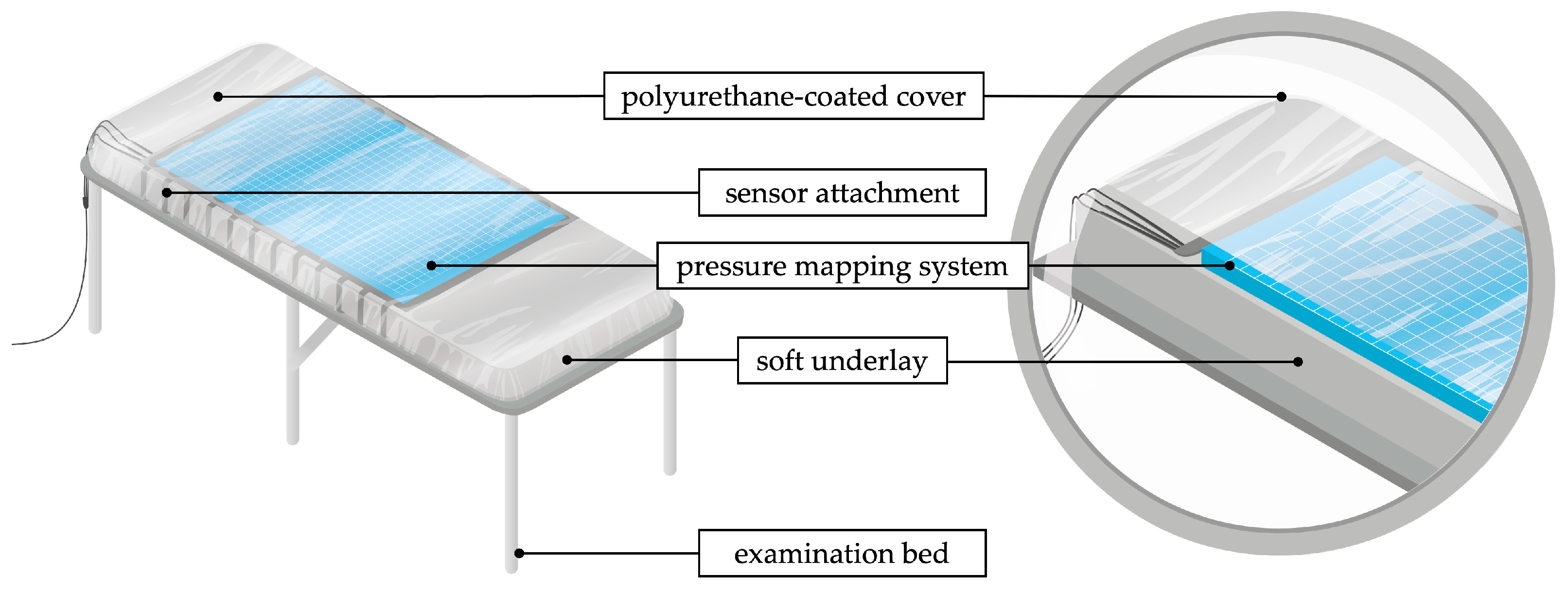
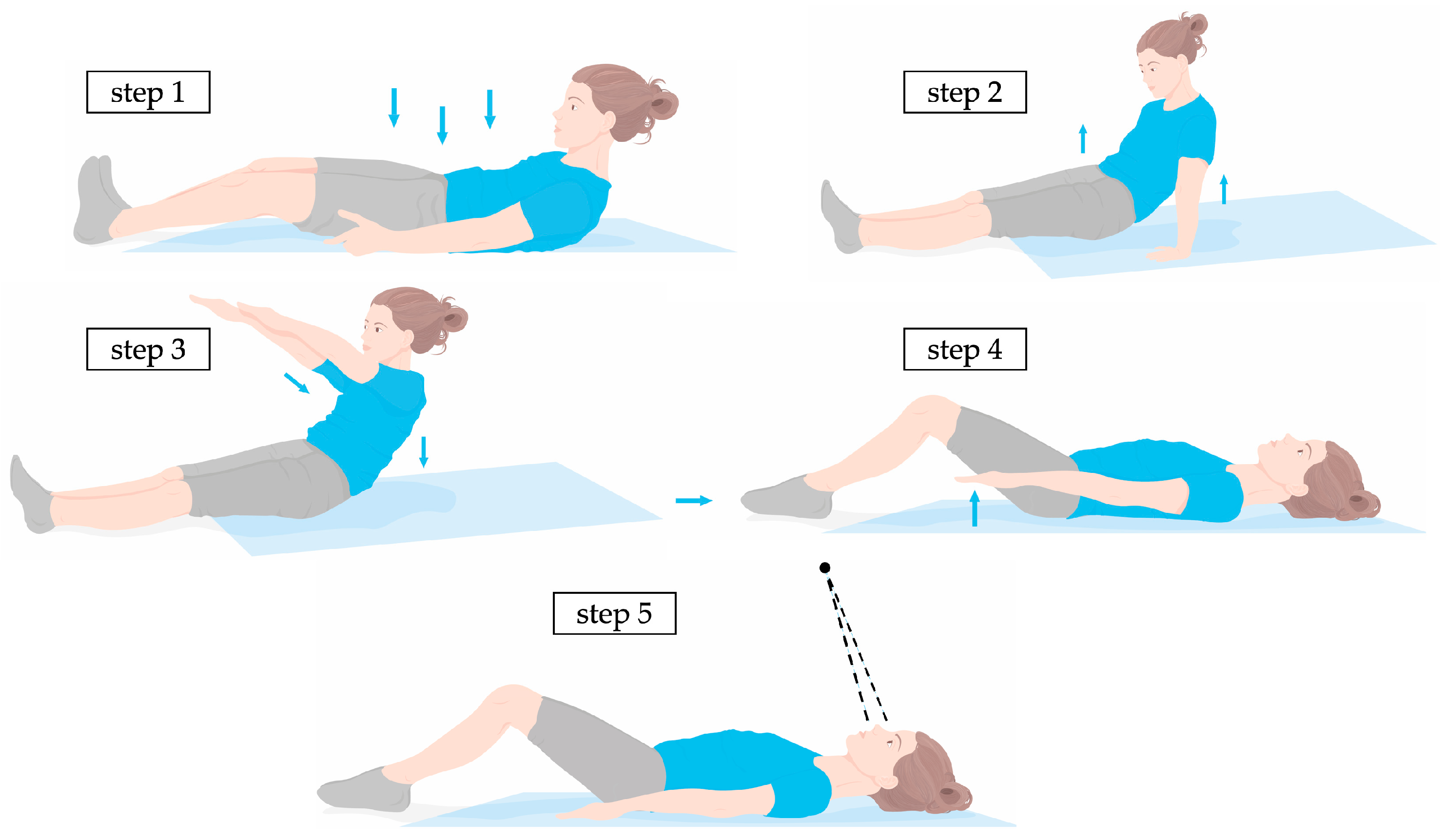
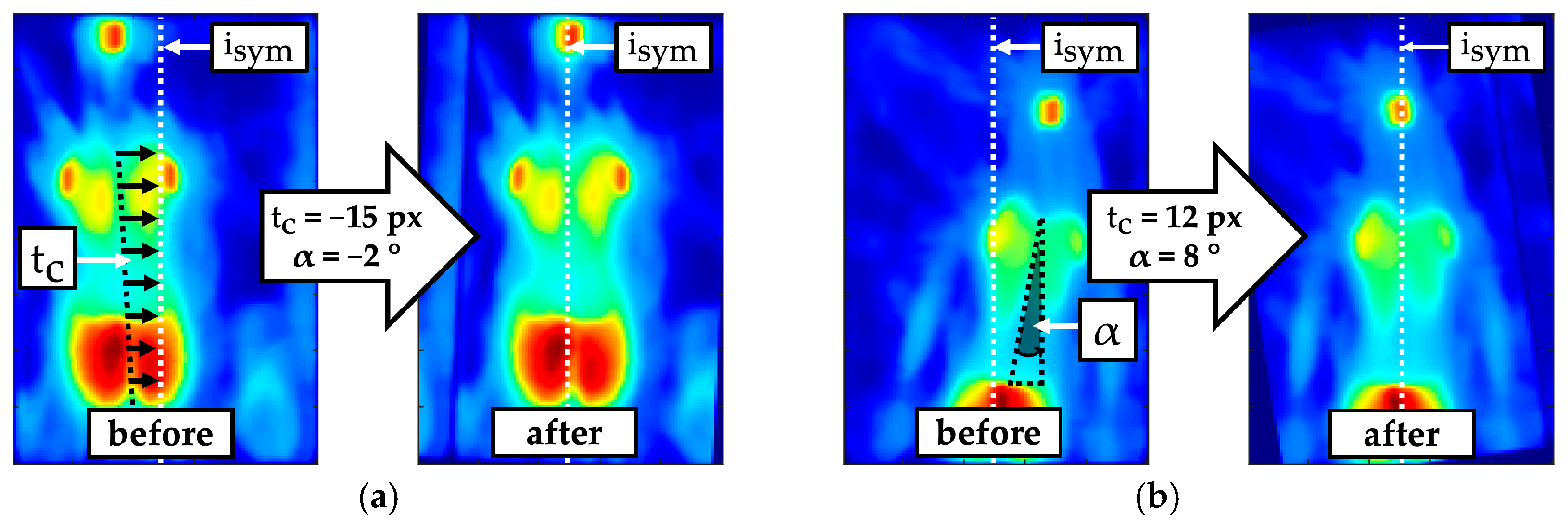
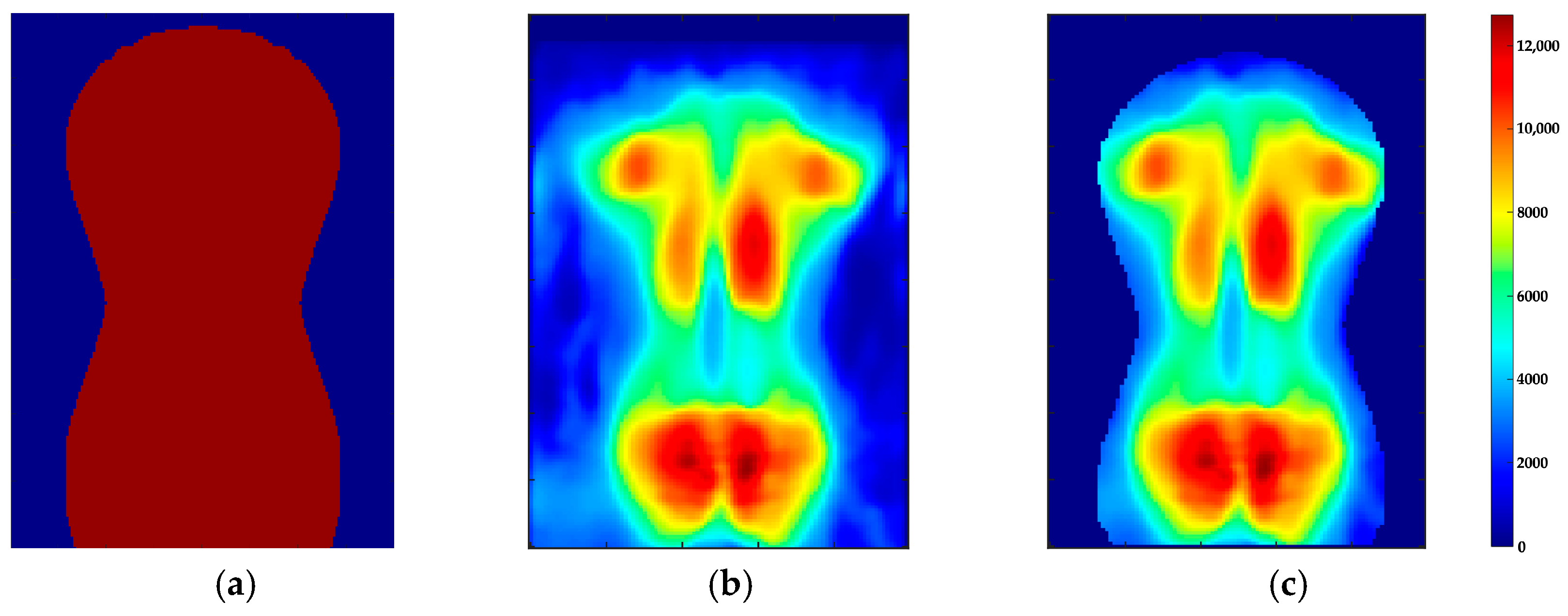
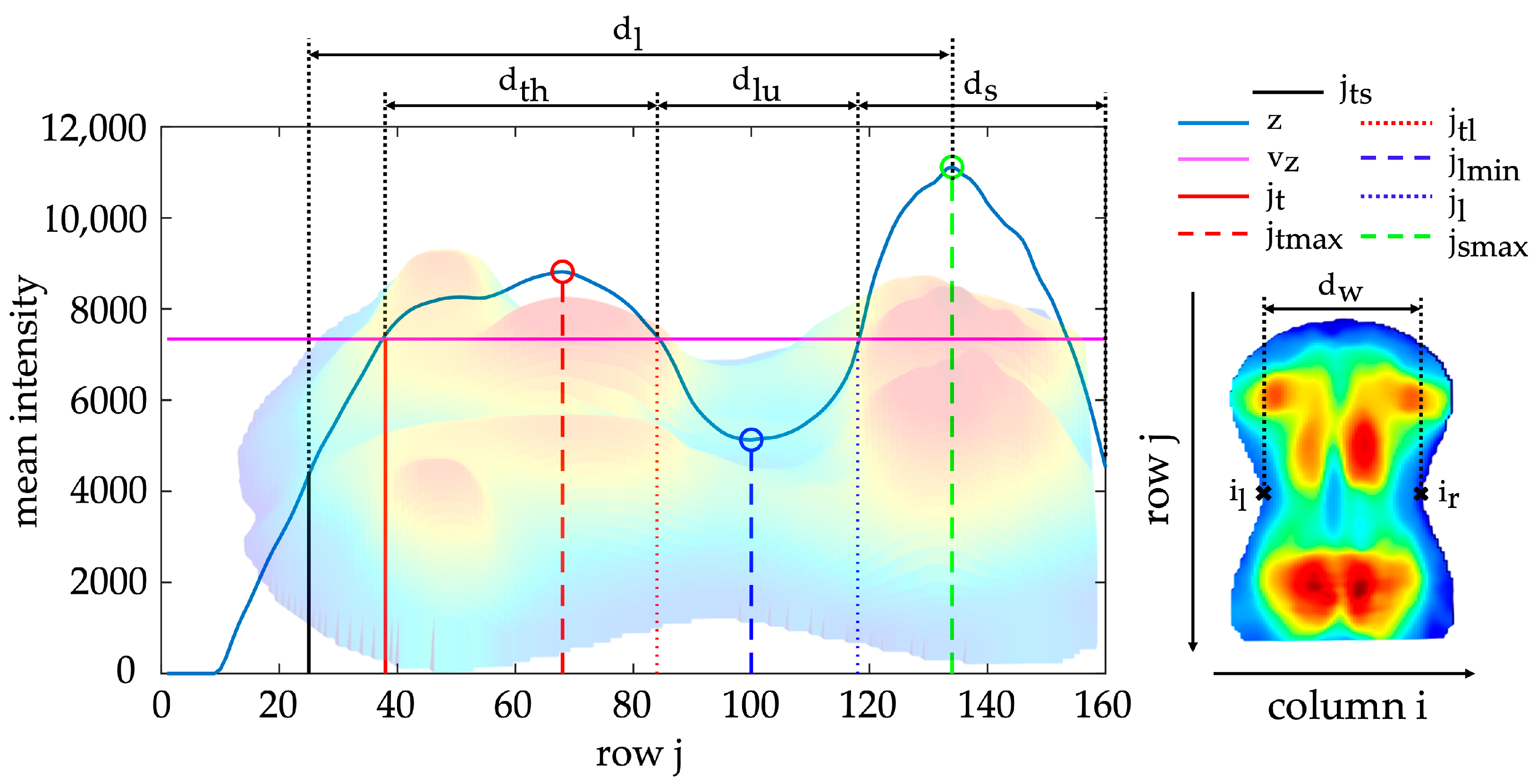



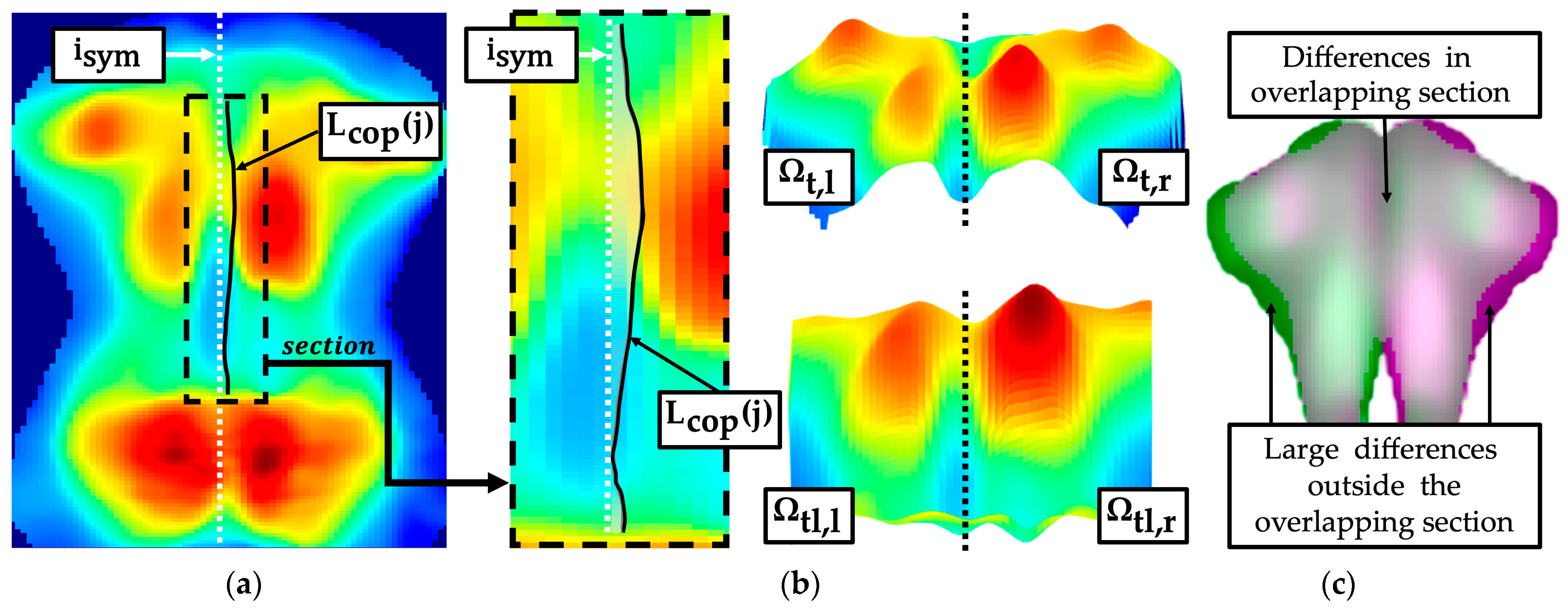


| Specification | Parameter Extraction | Diagnostic Medical Feature | |
|---|---|---|---|
| Spinal shape | Frontal curve | Lateral curvature of the concave canal in the spinal range | Lateral curvature of the spine |
| Sagittal curve | Curvature characteristics of the pressure intensities along the longitudinal axis | Imbalance of thoracic kyphosis and lumbar lordosis | |
| Thoracic region | Shoulder contour | Symmetry of the shoulder contour (position, morphology) | Height difference of the shoulder and shoulder protraction |
| Shoulder blades | Symmetry of the accentuated scapula maxima (position, intensity) | Unequal shoulders due to height difference or uneven protrusion | |
| Torso symmetry * | Symmetry of pressure intensities in the thoracic to lumbar region (intensity, morphology) | Asymmetrical trunk due to rib hump or lumbar prominence | |
| Lumbar region | Waist contour | Symmetry of the waist contour (position, morphology) | Waist asymmetry |
| Sacral region | Sagittal | Slope of the pressure intensities in the lumbar–sacral region | Abnormal pelvic tilt |
| Pelvic contour | Positional symmetry of the pelvic contour | Pelvic obliquity | |
| Pelvic symmetry | Intensity symmetry in the sacral region | Pelvic torsion or pelvic rotation |
| Landmarks and Reference Distances | Mean | SD | CV (%) | ICC(1,1) | 95% CI | ||
|---|---|---|---|---|---|---|---|
| (px) | (mm) | (px) | (mm) | ||||
| Torso start | 31.7 | 161.7 | 1.9 | 9.7 | 6.1 | 0.882 | 0.829–0.927 |
| Thoracic regions start | 39.9 | 203.5 | 1.6 | 8.2 | 4.1 | 0.917 | 0.877–0.949 |
| Thoracic maximum | 51.7 | 263.7 | 1.6 | 8.2 | 3.1 | 0.913 | 0.871–0.946 |
| Thoracolumbar transition | 72.3 | 368.7 | 2.4 | 12.2 | 3.3 | 0.841 | 0.773–0.899 |
| Lumbar minimum | 93.1 | 474.8 | 3.3 | 16.8 | 3.5 | 0.584 | 0.468–0.708 |
| Lumbar regions end | 111.3 | 567.6 | 1.8 | 9.2 | 1.6 | 0.885 | 0.833–0.928 |
| Sacral maximum | 130.2 | 664.0 | 2.0 | 10.2 | 1.6 | 0.684 | 0.580–0.788 |
| Left reference position | 23.9 | 121.9 | 0.6 | 3.1 | 2.4 | 0.893 | 0.844–0.934 |
| Right reference position | 74.5 | 380.0 | 0.5 | 2.6 | 0.7 | 0.918 | 0.880–0.950 |
| Torso length | 99.5 | 507.5 | 2.3 | 11.7 | 2.3 | 0.798 | 0.717–0.870 |
| Torso width | 51.6 | 263.2 | 1.1 | 5.6 | 2.1 | 0.911 | 0.870–0.945 |
| Thoracic region length | 33.4 | 170.3 | 1.9 | 9.7 | 5.7 | 0.846 | 0.780–0.903 |
| Lumbar region length | 40.0 | 204.0 | 2.3 | 11.7 | 6.2 | 0.896 | 0.848–0.936 |
| Sacral region length | 49.7 | 253.5 | 1.8 | 9.2 | 3.5 | 0.885 | 0.833–0.928 |
| Parameters | Eq. | Mean | SD | CV (%) | ICC(1,1) | 95% CI | ||
|---|---|---|---|---|---|---|---|---|
| Frontal spine curve | (px) | (8) | 2.5 | 0.7 | 30.5 | 0.492 | 0.374–0.629 | |
| (mm) | 12.8 | 3.6 | ||||||
| () | (9) | 0.4 | 0.3 | 69.9 | 0.572 | 0.455–0.698 | ||
| () | 10.4 | 7.0 | ||||||
| (n. d.) | (10) | 0.99 | 0.01 | 1.3 | 0.436 | 0.320–0.577 | ||
| (px) | (11) | 1.1 | 0.6 | 62.6 | 0.458 | 0.340–0.597 | ||
| (mm) | 5.6 | 3.1 | ||||||
| (px) | (12) | 1.5 | 0.5 | 36.8 | 0.318 | 0.212–0.460 | ||
| (mm) | 7.7 | 2.6 | ||||||
| (px) | (13) | 19.7 | 8.6 | 44.7 | 0.395 | 0.281–0.538 | ||
| (mm) | 100.5 | 43.9 | ||||||
| (n. d.) | (14) | 0.02 | 0.01 | 60.4 | 0.449 | 0.332–0.590 | ||
| Sagittal spine curve | (n. d.) | (15) | 1.47 | 0.21 | 12.4 | 0.855 | 0.793–0.909 | |
| (n. d.) | (16) | 1.89 | 0.47 | 21.3 | 0.650 | 0.540–0.761 | ||
| (n. d.) | (17) | 1.40 | 0.07 | 4.8 | 0.838 | 0.769–0.897 | ||
| (n. d.) | (18) | 1.07 | 0.12 | 11.2 | 0.836 | 0.766–0.896 | ||
| (n. d.) | (19) | 1.22 | 0.03 | 2.6 | 0.868 | 0.810–0.917 | ||
| (n. d.) | (20) | 82.18 | 12.22 | 15.8 | 0.842 | 0.775–0.900 | ||
| (n. d.) | (21) | 1.16 | 0.02 | 1.4 | 0.848 | 0.783–0.904 | ||
| (n. d.) | (22) | 0.84 | 0.03 | 3.7 | 0.830 | 0.759–0.892 | ||
| Parameters | Eq. | Mean | SD | CV (%) | ICC(1,1) | 95% CI | ||
|---|---|---|---|---|---|---|---|---|
| Shoulder contour | (px) | (23) | 31.3 | 2.1 | 6.8 | 0.868 | 0.809–0.917 | |
| (mm) | 159.6 | 10.7 | ||||||
| (px) | (23) | 30.5 | 2.0 | 6.7 | 0.866 | 0.807–0.916 | ||
| (mm) | 155.6 | 10.2 | ||||||
| (px) | (23) | 1.3 | 0.8 | 72.5 | 0.315 | 0.209–0.456 | ||
| (mm) | 6.6 | 4.1 | ||||||
| (n. d.) | (24) | 1.41 | 0.30 | 19.1 | 0.346 | 0.237–0.489 | ||
| (n. d.) | (24) | 0.54 | 0.09 | 17.6 | 0.732 | 0.636–0.823 | ||
| (n. d.) | (24) | 0.46 | 0.10 | 22.2 | 0.664 | 0.556–0.772 | ||
| Shoulder blades | (px) | (25) | 50.6 | 2.1 | 4.2 | 0.872 | 0.815–0.920 | |
| (mm) | 258.1 | 10.7 | ||||||
| (px) | (26) | 50.2 | 1.9 | 4.0 | 0.871 | 0.814–0.919 | ||
| (mm) | 256.0 | 9.7 | ||||||
| (px) | (25) | 30.7 | 1.0 | 3.1 | 0.801 | 0.722–0.872 | ||
| (mm) | 156.6 | 5.1 | ||||||
| (px) | (26) | 67.9 | 1.1 | 1.7 | 0.732 | 0.636–0.823 | ||
| (mm) | 346.3 | 5.6 | ||||||
| (px) | (27) | 1.9 | 1.3 | 78.1 | 0.345 | 0.236–0.488 | ||
| (mm) | 9.7 | 6.6 | ||||||
| (px) | (28) | 1.8 | 1.3 | 78.3 | 0.279 | 0.178–0.418 | ||
| (mm) | 9.2 | 6.6 | ||||||
| (°) | (29) | 2.9 | 2.0 | 78.4 | 0.333 | 0.225–0.475 | ||
| (n. d.) | (30) | 1.05 | 0.03 | 2.4 | 0.478 | 0.360–0.616 | ||
| (prv) | (30) | 1.30 × 104 | 450 | 3.4 | 0.772 | 0.685–0.852 | ||
| (prv) | (30) | 1.27 × 104 | 367 | 2.8 | 0.836 | 0.767–0.896 | ||
| (n. d.) | (31) | 1.02 | 0.01 | 1.2 | 0.313 | 0.208–0.454 | ||
| (prv) | (31) | 1.15 × 104 | 186 | 1.6 | 0.808 | 0.731–0.877 | ||
| (prv) | (31) | 1.14 × 104 | 182 | 1.6 | 0.834 | 0.764–0.895 | ||
| Torso symmetry | (px) | (36) | 50.7 | 12.3 | 26.3 | 0.582 | 0.466–0.706 | |
| (mm) | 258.6 | 62.7 | ||||||
| (n. d.) | (37) | 1.03 | 0.02 | 1.8 | 0.384 | 0.271–0.527 | ||
| (prv) | (37) | 8.26 × 103 | 207 | 2.6 | 0.863 | 0.802–0.914 | ||
| (prv) | (37) | 8.23 × 103 | 198 | 2.4 | 0.861 | 0.800–0.913 | ||
| (n. d.) | (38) | 1.02 | 0.01 | 0.9 | 0.592 | 0.477–0.715 | ||
| (prv) | (38) | 1.11 × 104 | 138 | 1.2 | 0.910 | 0.868–0.945 | ||
| (prv) | (38) | 1.10 × 104 | 146 | 1.3 | 0.890 | 0.840–0.932 | ||
| (n. d.) | (39) | 1.25 | 0.15 | 11.1 | 0.564 | 0.447–0.691 | ||
| (prv) | (39) | 6.15 × 106 | 1.07 × 106 | 21.2 | 0.696 | 0.593–0.796 | ||
| (prv) | (39) | 5.96 × 106 | 1.08 × 106 | 21.4 | 0.722 | 0.624–0.816 | ||
| (%) | (40) | 11.5 | 2.4 | 22.3 | 0.561 | 0.444–0.689 | ||
| Parameters | Eq. | Mean | SD | CV (%) | ICC(1,1) | 95% CI | ||
|---|---|---|---|---|---|---|---|---|
| Waist contour | (px) | (41) | 92.5 | 2.9 | 3.1 | 0.664 | 0.557–0.772 | |
| (mm) | 471.8 | 14.8 | ||||||
| (px) | (42) | 89.8 | 2.9 | 3.2 | 0.688 | 0.584–0.790 | ||
| (mm) | 458.0 | 14.8 | ||||||
| (px) | (41) | 18.8 | 0.8 | 4.7 | 0.864 | 0.804–0.915 | ||
| (mm) | 95.9 | 4.1 | ||||||
| (px) | (42) | 17.5 | 0.8 | 4.8 | 0.871 | 0.814–0.919 | ||
| (mm) | 89.3 | 4.1 | ||||||
| (px) | (43) | 3.4 | 2.2 | 67.4 | 0.390 | 0.277–0.533 | ||
| (mm) | 17.3 | 11.2 | ||||||
| (px) | (44) | 1.5 | 0.9 | 64.9 | 0.229 | 0.137–0.361 | ||
| (mm) | 7.7 | 4.6 | ||||||
| (°) | (45) | 5.4 | 3.3 | 66.7 | 0.425 | 0.309–0.567 | ||
| (n. d.) | (46) | 1.35 | 0.21 | 14.6 | 0.689 | 0.585–0.791 | ||
| (n. d.) | (46) | 1.08 × 10−2 | 1.93 × 10−3 | 18.9 | 0.733 | 0.637–0.824 | ||
| (n. d.) | (46) | 1.00 × 10−2 | 1.75 × 10−3 | 18.2 | 0.726 | 0.629–0.819 | ||
| Parameters | Eq. | Mean | SD | CV (%) | ICC(1,1) | 95% CI | ||
|---|---|---|---|---|---|---|---|---|
| Pelvic posture | (px) | (47) | 117.3 | 2.3 | 2.0 | 0.733 | 0.637–0.824 | |
| (mm) | 598.2 | 11.7 | ||||||
| (px) | (48) | 117.0 | 2.3 | 2.0 | 0.747 | 0.654–0.834 | ||
| (mm) | 596.7 | 11.7 | ||||||
| (px) | (47) | 148.7 | 1.8 | 1.2 | 0.571 | 0.454–0.697 | ||
| (mm) | 758.4 | 9.2 | ||||||
| (px) | (48) | 148.5 | 1.7 | 1.1 | 0.665 | 0.558–0.773 | ||
| (mm) | 757.4 | 8.7 | ||||||
| (prv/px) | (49) | 120.6 | 17.8 | 15.4 | 0.771 | 0.684–0.851 | ||
| (px) | (50) | 2.5 | 1.5 | 62.2 | 0.212 | 0.124–0.342 | ||
| (mm) | 12.8 | 7.7 | ||||||
| (n. d.) | (51) | 1.13 | 0.09 | 8.1 | 0.203 | 0.116–0.331 | ||
| (prv) | (51) | 5.11 × 106 | 7.78 × 105 | 15.3 | 0.608 | 0.494–0.728 | ||
| (prv) | (51) | 4.81 × 106 | 7.33 × 105 | 15.4 | 0.651 | 0.542–0.762 | ||
| (n. d.) | (52) | 1.01 | 3.65 × 105 | 0.4 | 0.284 | 0.183–0.423 | ||
| (prv) | (52) | 1.13 × 104 | 80 | 0.7 | 0.873 | 0.816–0.920 | ||
| (prv) | (52) | 1.13 × 104 | 83 | 0.7 | 0.858 | 0.796–0.911 | ||
Disclaimer/Publisher’s Note: The statements, opinions and data contained in all publications are solely those of the individual author(s) and contributor(s) and not of MDPI and/or the editor(s). MDPI and/or the editor(s) disclaim responsibility for any injury to people or property resulting from any ideas, methods, instructions or products referred to in the content. |
© 2024 by the authors. Licensee MDPI, Basel, Switzerland. This article is an open access article distributed under the terms and conditions of the Creative Commons Attribution (CC BY) license (https://creativecommons.org/licenses/by/4.0/).
Share and Cite
Stecher, N.; Heinke, A.; Żurawski, A.Ł.; Harder, M.R.; Schumann, P.; Jochim, T.; Malberg, H. Torsobarography: Intra-Observer Reliability Study of a Novel Posture Analysis Based on Pressure Distribution. Sensors 2024, 24, 768. https://doi.org/10.3390/s24030768
Stecher N, Heinke A, Żurawski AŁ, Harder MR, Schumann P, Jochim T, Malberg H. Torsobarography: Intra-Observer Reliability Study of a Novel Posture Analysis Based on Pressure Distribution. Sensors. 2024; 24(3):768. https://doi.org/10.3390/s24030768
Chicago/Turabian StyleStecher, Nico, Andreas Heinke, Arkadiusz Łukasz Żurawski, Maximilian Robert Harder, Paula Schumann, Thurid Jochim, and Hagen Malberg. 2024. "Torsobarography: Intra-Observer Reliability Study of a Novel Posture Analysis Based on Pressure Distribution" Sensors 24, no. 3: 768. https://doi.org/10.3390/s24030768
APA StyleStecher, N., Heinke, A., Żurawski, A. Ł., Harder, M. R., Schumann, P., Jochim, T., & Malberg, H. (2024). Torsobarography: Intra-Observer Reliability Study of a Novel Posture Analysis Based on Pressure Distribution. Sensors, 24(3), 768. https://doi.org/10.3390/s24030768






